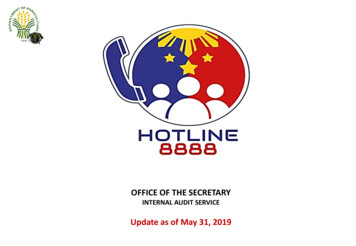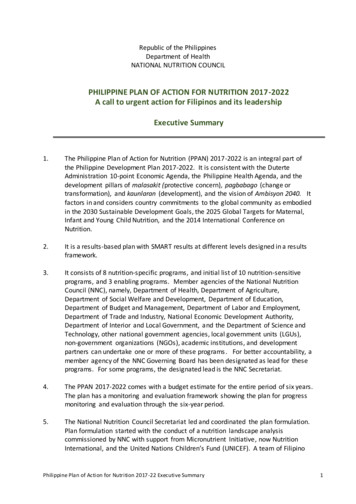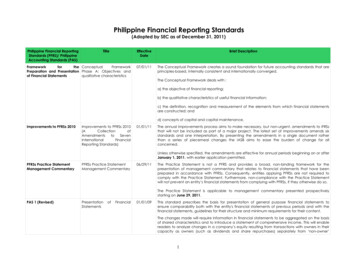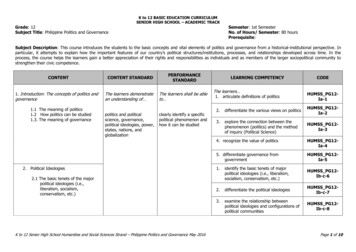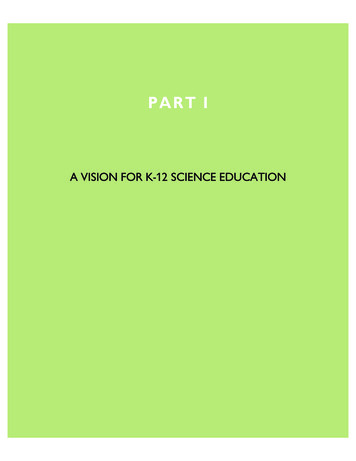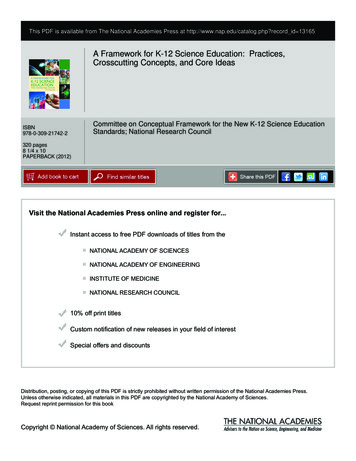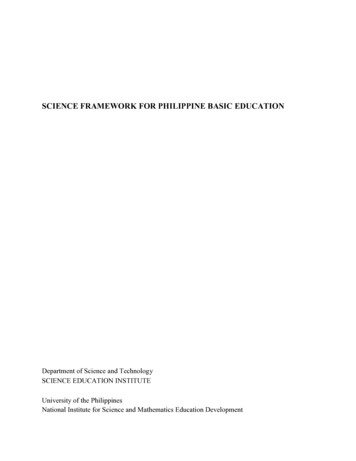
Transcription
SCIENCE FRAMEWORK FOR PHILIPPINE BASIC EDUCATIONDepartment of Science and TechnologySCIENCE EDUCATION INSTITUTEUniversity of the PhilippinesNational Institute for Science and Mathematics Education Development
Science Framework for Philippine Basic EducationAll rights reserved. 2011 by the Science Education Institute, Department of Science and Technology (SEI-DOST)and the University of the Philippines National Institute for Science and Mathematics Education Development (UP NISMED),Manila, PhilippinesCitation:SEI-DOST & UP NISMED, (2011). Science framework for philippine basic education.Manila: SEI-DOST & UP NISMED.ISBN 978-971-8600-46-7Published by:Science Education Institute, Department of Science and Technology1st and 2nd Levels, Science Heritage BuildingDOST Compound, General Santos AvenueBicutan, Taguig City, Metro Manila, PhilippinesTel. Nos. (632) 837-1359, (632) 839-0241, Fax No. (632) 837-1924http://www.sei.dost.gov.ph / www.science-scholarships.ph andUniversity of the Philippines National Institute for Science and Mathematics Education DevelopmentE. Quirino Avenue, UP CampusDiliman, Quezon City 1101 PhilippinesTel. No. (632) 927-4276, Fax No. (632) 928-3545http://www.upd.edu.ph/ ismed/ e-mail: nismed@up.edu.phRequest for permission to use any material from this publication or for further information should be addressed to the copyrightholders.Printed in Metro Manila, Philippines
ForewordThis framework is the product of months of careful planning and discussions, with ideascoming from the best minds in the field of science, prior to the actual drafting of themanuscript. Although there may have been opposing views during the development of thisframework, which is not unusual when experts meet, the final output is proof that individualswith diverse backgrounds and beliefs could be united by a common vision and goal.The “Science Framework for Philippine Basic Education” contains resources that will helpcurriculum developers, teachers, school administrators and policy makers to design andimplement science curricula that empower students to “learn to learn” and cause them to betterunderstand and use science in their everyday life. The strategies consider only Grades 1-10,however, because of the progressive nature of the concepts, curriculum development couldeasily be extended to cover K-12.It is hoped that this framework will be widely used and applied by the various stakeholders,and that together we will work towards achieving the vision of scientifically, technologically,environmentally literate and productive individuals through quality science education.Dr. Filma G. BrawnerDirector, Science Education Institute
C ONTENTSI.Overview . . . . . . . . . . . . . . . . . . . . . . . . . . . . . . . . . . . . . . . . . . . . . . . . . . . . . . . . . . . .1Importance of the School Science Education . . . . . . . . . . . . . . . . . . . . . . . . .Challenges in Science Education: Philippines Context . . . . . . . . . . . . . . . . . .Rationale . . . . . . . . . . . . . . . . . . . . . . . . . . . . . . . . . . . . . . . . . . . . . . . . . . . . . . .The Project Output and Team Members . . . . . . . . . . . . . . . . . . . . . . . . . . . .For Whom is the Framework . . . . . . . . . . . . . . . . . . . . . . . . . . . . . . . . . . . . . .The Guiding Principles of Science Curriculum Framework . . . . . . . . . . . . . . .112344II.What is in the Framework . . . . . . . . . . . . . . . . . . . . . . . . . . . . . . . . . . . . . . . . . . . . .6III.Curriculum Components . . . . . . . . . . . . . . . . . . . . . . . . . . . . . . . . . . . . . . . . . . . . . . .9 Component 1: Inquiry Skills . . . . . . . . . . . . . . . . . . . . . . . . . . . . . . . . . . . . . . . 9Component 2: Scientific Attitudes . . . . . . . . . . . . . . . . . . . . . . . . . . . . . . . . . . 12Component 3: Content and Connections . . . . . . . . . . . . . . . . . . . . . . . . . . . . 17References . . . . . . . . . . . . . . . . . . . . . . . . . . . . . . . . . . . . . . . . . . . . . . . . . . . . . . . . . . . . . . . . 21ANNEXESFocus Questions, Science Ideas and Sample Learners’ PerformanceABCDEFocus Questions on Each Subject Area. . . . . . . . . . . . . . . . . . . . . . . . . . . . . . . . 24Focus Questions in Each Grade Range. . . . . . . . . . . . . . . . . . . . . . . . . . . . . . . . 35Life Science . . . . . . . . . . . . . . . . . . . . . . . . . . . . . . . . . . . . . . . . . . . . . . . . . . . . . 45Physical ScienceD-1 Force, Motion and Energy. . . . . . . . . . . . . . . . . . . . . . . . . . . . . . . . . . . . . . 72D-2 Matter. . . . . . . . . . . . . . . . . . . . . . . . . . . . . . . . . . . . . . . . . . . . . . . . . . . . . . 95Earth and Space . . . . . . . . . . . . . . . . . . . . . . . . . . . . . . . . . . . . . . . . . . . . . . . . . 115
SCIENCE CURRICULUM FRAMEWORKFOR BASIC EDUCATIONI. OverviewScience is important to everyone. School science education should support thedevelopment of scientific literacy in all students as well as motivate them to pursue careersin science, technology, and engineering. These statements were drawn from a series ofconsultation meetings and focus group discussions with different sectors of society held in2006: industry, university, scientists, parents, teachers, school administrators, communityleaders, media, students, and many others. Importance of the School Science EducationScience is useful because of its links to technology and industry, which, from anational perspective, are areas of high priority for development. Science provides ways ofmaking sense of the world systematically. It develops students’ scientific inquiry skills,values and attitudes, such as objectivity, curiosity, and honesty and habits of mind includingcritical thinking. All these are useful to the individual student for his own personaldevelopment, future career, and life in general. These skills, values, attitudes, anddispositions are likewise useful to the community that an individual student belongs to, andare further useful to the country that he lives in.The learning of science is also important for the nation’s cultural development andpreservation of its cultural identity. Science is most useful to a nation when it is utilized tosolve its own problems and challenges, keeping a nation's cultural uniqueness andpeculiarities intact. Thus in many countries, science teaching and learning is linked withculture. Challenges in Science Education: Philippines ContextSome Filipino students have gained recognition for their high level ofaccomplishments in the International Science and Engineering Fair, Robotics Competition,and Physics Olympiad, to name a few. There are also reports of students in far-flung ruralschools scoring much higher than the international mean in the case of the Third/Trends inInternational Mathematics and Science Study (TIMSS) or have gone beyond the 75%mastery level in the case of the National Achievement Test (NAT).SCIENCE CURRICULUM FRAMEWORK FOR BASIC EDUCATION1
However, the accomplishments of a few students are overshadowed by theconsistently poor performance of Filipino students in international assessment studies andnational assessment studies. Studies reveal that Filipino students have low retention ofconcepts, have limited reasoning and analytical skills, and poor communication skills (theycannot express ideas or explanations of events and phenomena in their own words) (UPNISMED, 2004). In addition, a large percentage of Grade 6 and fourth year students inselected schools cannot apply concepts to real-life problem solving situations nor design aninvestigation to solve a problem (UP NISMED, 2005).Many educators and graduate student researchers have identified several factorsbehind the low performance in science of Filipino students. These are: quality of teachers,the teaching-learning process, the school curriculum, instructional materials, andadministrative support (DOST-SEI, 2006).There are many efforts by various stakeholders in science education to address theseconcerns. The UP National Institute for Science and Mathematics Education Developmentwith three major functions–curriculum development, training and research in science andmathematics (UP Board of Regents, 1997), designated as the National Center forInnovations and Research (DOST SEI, 2005), deemed it wise to focus its efforts on thescience curriculum to improve the quality of education at the elementary and secondaryschool levels. The curriculum dictates how instruction and assessment of student learningshould be done and guides service providers in designing professional developmentprograms for teachers. RationaleIn the Philippines and around the world, people are talking about a science andtechnology-based world and a knowledge-based economy. Given the expectations and skillsrequired to live successfully in such an environment and the varied problems of scienceeducation in the country, there is a need to rethink what the vision of science education is.The current direction of curriculum development in many countries is towardsscientific literacy, where the science education needs of all students are differentiated fromthose who have an interest in scientific careers. An example is York University’s 21stCentury Science, which has a Foundation Science subject to be taken by all students, and asecond optional subject, Additional Science, for those students who wish to proceed withdisciplines in science in later years.Several questions have been asked: Does the present science curriculum for basiceducation address the needs of students from different communities who might drop out ofschool at different grade or year levels? Does the science curriculum in basic educationprovide avenues for students to engage in science and encourage them to take sciencerelated careers? Does science in basic education help students become informed citizens soSCIENCE CURRICULUM FRAMEWORK FOR BASIC EDUCATION2
that they can participate in making wise decisions about issues that involve science andtechnology now and when they become decision makers in government and in industry?These questions were deliberated on lengthily by science education specialists,cognitive psychologists, and even school teachers. They also noted that the existing sciencecurriculum at the basic education level do not jibe with the expectations of industry, theuniversity, and society in general. More specifically, they observed that the presentcurriculum is overloaded, discipline-based, and caters to college bound students. Theybased their conclusion on the data that drop out rate is high, that is, for every 100 pupilsthat enroll in Grade 1, only 65 finish Grade 6; while 56 students enroll in secondary school,only 46 graduate in fourth year (BESRA, 2006). In addition, of those who pursue tertiaryeducation, only about 2% choose careers in science and related fields.The present science curriculum was updated a few years back (RBEC, 2003) but thesame description in terms of its content and emphasis still hold.Thus, the Project Team arrived at these vision statements:The Philippines’ Grades 1-10 Science Curriculum envisions the development ofscientifically, technologically, and environmentally literate and productive members ofsociety. They must possess effective communication and interpersonal and life longlearning skills as well as scientific values and attitudes. These skills will be acquiredthrough a curriculum that focuses on knowledge relevant to real world and encompassesmethods of inquiry. These will be implemented in a learning environment that promotesthe construction of ideas and instills respect for others.The Framework begins at Grade 1 because the kindergarten curriculum cannot bepigeonholed into the usual subjects in basic education, such as science, mathematics,reading, and writing. Even though concepts from these subjects are taught every day inkindergarten, they are so interrelated that it is difficult to distinguish one from another. The Project Output and Team MembersThe major output is a coherent, comprehensive science curriculum framework forbasic education with development of scientific inquiry as its overarching emphasis. Itpromotes the core science concepts and skills to enable students “learn how to learn.”This science curriculum framework is a result of a series of brainstorming andmarathon sessions to rethink the vision for Grades 1-10 school science based on theexpectations for citizens in a technologically-driven world. Its goals and content areoriented towards producing scientifically literate citizens, and decision makers. It takes intoaccount emerging social and global issues and concerns, new international trends incurriculum planning and design, and other pedagogical developments.SCIENCE CURRICULUM FRAMEWORK FOR BASIC EDUCATION3
The Core Group is composed of science educators, heads of professional scienceteachers’ organizations, scientists and engineers, teachers, and senior specialists andresearchers of DOST-SEI. The Technical Working Group is made up of science educationspecialists and science education associates of UP NISMED. For Whom is the FrameworkThe science curriculum framework is a resource for curriculum developers, faculty ofteacher education institutions, teachers, school administrators, and policy makers to design,implement, and assess the content of the science curricula.Specifically, the document will help schools, teachers, and instructional materialsdevelopers in addressing the needs of students to prepare them for the world of work, forpursuing their interest in science and related fields, and to become responsible citizens. Itemphasizes the need to learn and use real life contexts to enhance learning, develops skillsfor independent study or self-learning and inculcates in students the love and desire toacquire ‘learn how to learn’ skills.For school administrators, the science curriculum framework will guide them on theselection of quality instructional materials and equipment for science teaching and learning.This framework will also inform policy makers to formulate appropriate legislation aswell as allocate resources to support quality science education. The Guiding Principles of Science Curriculum FrameworkScience is for everyone. This principle recognizes the proactive relationship betweenscience and society. This means putting science into the service of individuals and society.Science education should aim for scientific literacy that is operational in understandingoneself, common human welfare, social, and civic affairs. Science should permeate all levelsof society. Whether or not students pursue a university education, they should leave schoolwith a level of understanding and scientific literacy that will prepare them to be informedand participative citizens who are able to make judgments and decisions regarding scienceapplications that may have social, health, or environmental impacts.Science is both content and process. Science content and science process areintertwined. The value of science processes is to advance content or the body ofknowledge. Without content, students will have difficulty utilizing the science process skills.Science processes cannot exist in a vacuum. They are learned in context.School science should emphasize depth rather breadth, coherence rather thanfragmentation, and use of evidence in constructing explanation.SCIENCE CURRICULUM FRAMEWORK FOR BASIC EDUCATION4
School science should be relevant and useful. To be relevant and useful, the teachingof science should be organized around situations, problems or projects that engage thestudents both as an individual and a member of a team.School science should nurture interest in learning. Students are generally interestedin problems that puzzle them. They have a natural urge to find solutions. Organizing thecurriculum around problems or phenomena that puzzle students helps motivate them tolearn.Rather than relying solely on textbooks, teachers are encouraged to use hands-onlearning activities to develop students’ interest and let them become active learners.School science should demonstrate a commitment to the development of a cultureof science. A culture of science is characterized by excellence, integrity, hard work, anddiscipline.School science should promote the strong link between science and technology,including indigenous technology.School science should recognize that science and technology reflect, influence, andshape our culture. The science curriculum should recognize the place of science andtechnology in everyday human affairs. It should integrate science and technology in thecivic, personal, social, economic, and the values and ethical aspects of life.SCIENCE CURRICULUM FRAMEWORK FOR BASIC EDUCATION5
II. What is in the FrameworkThe curriculum framework is the overall structure for organizing learning andteaching. It ensures that learning experiences provided to students are commensurate withtheir abilities at different stages and with their ways of perceiving and learning about theworld. The framework is not the curriculum itself. Rather, it is a skeleton that provides thebasis for a strong, organized, and cohesive curriculum.It is not a syllabus, but a framework. According to Bybee (1990), “a framework is likethe broad sketches of an architect’s plan. The framework gives an initial picture of theprogram and is based on certain specifications. The architect’s plan has to fulfill certainrequirements. At the same time, the more specific details are left to the contractors andthe carpenters. Everyone knows there will be modifications as the framework is developedand implemented, but there should be some fidelity to the original intentions,specifications, and design.”This Framework is organized around three interlocking components namely: (1)inquiry skills, (2) scientific attitudes, and (3) content and connections. Being interrelated,these components are woven together in order to support the holistic development of ascientifically literate individual. The Framework sets out what all students should know,understand, value, and be able to do from Grade 1 to Grade 10. The Technical WorkingGroup deems it best to use Grades 1-10 (G1-10) instead of Grades 1-Year 4 to emphasizethat there is no break in the continuum of the curriculum from elementary school to highschool.Rather than being prescriptive, its basic purpose is to provide a structure aroundwhich educators, curriculum developers, textbook writers, and teachers can developinstructional materials incorporating coherent learning activities and experiences thatprepare students to become scientifically literate in a dynamic, rapidly changing, andincreasingly technological society.The Framework includes the core content that describes the major science conceptsthat all students are expected to learn to become scientifically literate as well as thecompetencies that indicate what students should be able to do and demonstrate at the endof Grade 2, Grade 4, Grade 6, Grade 8 and Grade 10. As such, it is envisioned to provide acommon curriculum direction so that a more even spread of curriculum support materialsare developed and professional development aligned with curriculum change areimplemented to the advantage of Filipino students.SCIENCE CURRICULUM FRAMEWORK FOR BASIC EDUCATION6
The Framework has two key features, which makes it different from previouscurriculum documents in the Philippines: its focus on the cohesiveness of the threecomponents and its Grade 1 to Grade 10 approach. While particular grade levels makeunique contributions and may require different approaches, the G1-10 approach adoptedby the Framework provides a picture of the total span of the basic education of students. Itencourages a developmental and integrated approach to curriculum planning, teaching, andlearning. It addresses the need to develop students’ understanding of the big ideas ofscience over the years rather than over weeks and months and the importance ofconsidering both content knowledge and its applications. It enables students to progresssmoothly through the grade levels and avoids the major disjunctions between stages ofschooling evident in some previous approaches to curriculum. Thus, it provides the basis forcontinuity and consistency in the students’ basic education.Taken as a whole, students in each grade level learn about the three content areas(life science, physical science, and earth and space science) in one school year. Such anorganization emphasizes understanding the connections and interrelationship of variousscience concepts. This is in contrast to the traditional presentation of science content asseparate subjects where knowledge is taught to build mastery of a collection of isolatedfacts, principles, and procedures.There are three overarching themes: maintaining good health and living safely;utilizing energy and coping with changes; and conserving and protecting the environment.These themes are used in various real life contexts across grade levels. The latter is inkeeping with the pervasive trend in science education where the focus of the curriculum isSCIENCE CURRICULUM FRAMEWORK FOR BASIC EDUCATION7
from content-focused science to one that prepares students for better understanding anduse of science in their everyday life (Fensham, 2006).SCIENCE CURRICULUM FRAMEWORK FOR BASIC EDUCATION8
III. Curriculum ComponentsComponent 1: Inquiry SkillsScience is a way of thinking about and investigating the world in which we live. Thiscomponent addresses those skills scientists use to discover and explain physicalphenomena. These skills include asking questions about the world, designing andconducting investigations, employing different strategies to obtain information, andcommunicating results. Activities such as scientific investigations, experiments, projectwork, field work, group discussion, and debates allow students to be actively engaged in thefollowing processes.In the early grades, students should be exposed to science as a “hands-on, mindson” process and encouraged to explore and raise questions about the world around them.As they go up the grades, they should develop skills to design and conduct investigationsaddressing self-, as well as teacher-generated questions, and involving identifying andcontrolling variables.Through the grades, students should develop abilities tosystematically collect and organize data and communicate investigations, culminating inabilities to formulate explanations or models based on results of investigations.Among the inquiry skills that should be developed through the years of schooling isanalyzing and evaluating information, procedures, and claims. A person should not acceptevery piece of information offered to him as true without some analysis. When confrontedwith a certain claim, one should counter with, What is your basis for saying so? How do youknow? Why do you say so? One should always ask for supporting evidence, or search forfurther clarifying information. Moreover, one must develop the skill to recognize faultyarguments or reasoning that lumps facts and opinions together.The ability to make decisions based on sound judgment and logical reasoning is animportant inquiry skill that should be honed early on. People have to decide on many thingsin the course of a single day. What to eat, which to buy, how to get there. These mayappear to be simple questions requiring simple answers. But to arrive at the best answer,one must ask a string of other questions that will probe deeper into the situation.What to eat: Is it nutritious? Is it too oily or salty?Which to buy: Is it durable? Is it environment friendly?How to get there: Is it safe? Is it on time?Decision making is a skill that involves the use of other skills. To make gooddecisions, one must know how to analyze, evaluate, assess.These inquiry skills are summarized in the following chart.SCIENCE CURRICULUM FRAMEWORK FOR BASIC EDUCATION9
Grade LevelGrades 1-2Grades 3-4A. Askquestionsabout thenatural world(materials,events,phenomena,andexperiences) Askquestionsbased onobservations Askquestionsbased onobservationsB. Design and conductinvestigations usingappropriate procedure,materials, tools, andequipment to gatherevidenceC. Employdifferentstrategies toobtaininformation fromdifferent sourcesD. Communicateresults ofinvestigationsusing appropriatepresentationtools Use senses toobserve Use simple tools(e.g., hand lens) toobserve and collectdata Use differentstrategies inobtainingrelevantinformation(e.g. s,surveys) Use differentstrategies inobtainingrelevantinformation(e.g. s,surveys) Gatherinformationfrom availablesources printand non-printmaterials,resourcepersons) Cite sources ofinformation Draw/illustrateobservations Giveexplanationsbased onobservations Carry out simpletests to answerquestions and gatherevidence Collect data usingappropriate toolsand equipment Use metric systemSCIENCE CURRICULUM FRAMEWORK FOR BASIC EDUCATION Organize andexplain datausing tables,graphs andcharts Stateinferencesbased on data Proposeexplanationsbased onevidencegathered10
Grades 5-6 Ask scientificquestionsthat can beinvestigatedempiricallyGrades 7-8 Askquestionsoften builton priorknowledgethat can beinvestigatedempirically Carry out structuredscientificinvestigations- Visualize the stepsin an investigation- Identify variableswhich should beheld constant andone which shouldbe changed- Collect data usingappropriate toolsand equipment- Record andorganize data- Analyze andinterpret collecteddata- Hypothesizereasons for varyingresults obtained- State a conclusionbased on the data(may berelationshipbetween variables) Design and conductscientific semistructuredinvestigations- Identify theproblem to beinvestigated- Identify variablesinvolved in theinvestigation- Plan a procedure toanswer thequestion- Collect data usingappropriate toolsand equipment- Record andorganize data- Analyze andinterpret collecteddata Gatherrelevantinformationfrom reliablesources (e.g.print and nonprintmaterials,resourcepersons,websites) Cite sources ofinformation Present data indifferentformats (e.g.flow chart,schematicdiagrams,sketches andother availabletechnology Discuss topicsin groups Proposeexplanationsbased onevidencegathered Evaluatesources ofinformation(e.g. reliable,credible Gather relevantinformationfrom reliablesources (e.g.,print and ficjournals) Use sources ofinformation insupport ofinvestigationPrepare a writtenreport Summarizeideas gatheredfrom differentsources Present data inappropriateformats Justifyinterpretationof data Clarify orelaborateexplanationswith reasonsand evidenceSCIENCE CURRICULUM FRAMEWORK FOR BASIC EDUCATION11
Grades 9-10 Askquestionsbeyonddirectobservationswhich maybe based onscienceprinciples State a conclusionbased on the data(may be relationshipbetween variables) Design and conductunstructuredscientificinvestigation- Identify a problemto be investigated- State the objectivesof the investigation- Identify variablesinvolved in theinvestigation- Plan a procedure tosolve the problem- Collect data usingappropriate toolsand equipment- Record andorganize data- Analyze andinterpret collecteddata (considersources of error,limitations ofinstruments)- Consideralternative orpossibleexplanations ofdata Cite sources ofinformation Gatherrelevantinformationfrom reliablesources (e.g.,print and ficjournals) Cite referencesusing currentlyaccepted styles Write acompletereport ofinvestigation Summarizeand presentresults ofinvestigationusing ctivesComponent 2: Scientific AttitudesAnother component of the Science Curriculum Framework involves the developmentof certain attitudes in learners. These refer to values and habits of mind which are especiallyimportant in science and are necessary if students are to become lifelong learners andproductive citizens. Such attitudes should be developed from Grade 1 up to Grade 10 asthey are crucial in helping students appreciate the pleasure of learning to learn and toreduce their dependency on transmission of knowledge.SCIENCE CURRICULUM FRAMEWORK FOR BASIC EDUCATION12
Being scientifically literate goes beyond mere understanding of the basic concepts ofscience. Students learn the skills and methods of science by doing science. They learn thevalues and attitudes of science by applying them to science. Actively engaging students inscience helps them develop good attitudes and dispositions.The list below gives a brief description of some attitudes that should be developed asstudents do science.Critical Thinking. Development of inquiry skills contribute towards development ofcritical thinking in learners.Critical thinking skills are not taught directly. They are developed through inquiryactivities that students engage in and through their attempts to explain the outcomes oftheir investigations using evidence and logical argument. When making comparisons, theylearn to recognize when a comparison might be unfair because the conditions were notkept the same.The development of critical thinking in the elementary grades begins when theteacher asks the students “How do you know?” and they give reasonable answers. Theyaccept answers that are supported by observations, facts found in books or from otherreliable sources. They learn to rely on evidence to support their statements.In the first two years of secondary school, students should be given the opportunity topursue scientific questions that interest them. Group projects provide such opportunities ina context that encourages students to satisfy their curiosity, demonstrate honesty,skepticism, and per
The science curriculum framework is a resource for curriculum developers, faculty of teacher education institutions, teachers, school administrators, and policy makers to design, implement, and asse

